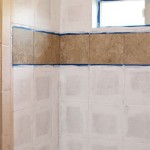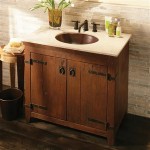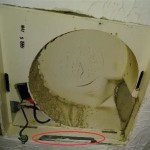Deep Basin Bathroom Sinks: A Comprehensive Overview
The bathroom sink is a fundamental fixture in any residential or commercial space, serving essential hygiene and aesthetic purposes. While standard sink designs are widely available and functional, deep basin bathroom sinks offer enhanced usability and design versatility. This article provides a comprehensive overview of deep basin bathroom sinks, exploring their characteristics, benefits, different types, installation considerations, and maintenance requirements.
A deep basin bathroom sink, as the name implies, is characterized by its greater bowl depth compared to traditional sinks. This increased depth offers a larger capacity for holding water, reducing the likelihood of splashing and making it more convenient for tasks such as handwashing, face washing, and filling containers. The specific depth that qualifies a sink as "deep basin" can vary depending on manufacturer and design, but it generally exceeds 6 inches.
Key Advantages of Deep Basin Bathroom Sinks
Deep basin sinks provide several advantages over standard counterparts, influencing both functionality and aesthetics within the bathroom.
Reduced Splashing: The primary benefit of a deep basin sink is its ability to minimize splashing. The increased depth contains water more effectively, preventing it from spraying onto the surrounding countertop, walls, or floor. This is particularly advantageous for households with children or individuals who tend to be less careful with water usage. The reduced splashing translates to less cleaning effort and a more hygienic environment.
Enhanced Capacity and Convenience: The larger bowl capacity allows for more comfortable and efficient use. Tasks such as washing delicate clothing items, filling water pitchers, or soaking small objects become significantly easier. The extra space within the sink bowl contributes to a more practical and user-friendly experience, particularly for individuals with specific needs or preferences regarding bathroom activities.
Aesthetic Appeal: Deep basin sinks often present a more contemporary and stylish appearance. The deeper bowl can create a more dramatic focal point in the bathroom, adding a touch of sophistication and visual interest. The design flexibility of deep basin sinks allows them to be integrated seamlessly into various bathroom styles, ranging from minimalist and modern to traditional and rustic.
Types of Deep Basin Bathroom Sinks
Deep basin bathroom sinks are available in a variety of mounting styles, materials, and shapes, providing options to suit diverse design preferences and functional requirements.
Undermount Sinks: Undermount sinks are installed beneath the countertop, creating a seamless and clean aesthetic. The rim of the sink is attached to the underside of the countertop, leaving a smooth and unobstructed surface. This design is easy to clean and prevents the accumulation of dirt and debris around the sink edge. Undermount deep basin sinks are a popular choice for modern and contemporary bathrooms.
Vessel Sinks: Vessel sinks, also known as above-counter sinks, sit directly on top of the countertop. These sinks serve as a prominent design element, adding a unique and eye-catching feature to the bathroom. Vessel sinks are available in a wide range of shapes, sizes, and materials, allowing for personalized customization. Deep basin vessel sinks offer both aesthetic appeal and enhanced functionality.
Drop-In Sinks (Self-Rimming Sinks): Drop-in sinks are installed by dropping into a pre-cut hole in the countertop. The rim of the sink sits flush with the countertop surface, providing a finished appearance. Drop-in sinks are relatively easy to install and are a cost-effective option. Deep basin drop-in sinks offer a combination of practicality and affordability.
Wall-Mounted Sinks: Wall-mounted sinks are attached directly to the wall, without the need for a countertop or vanity. This design creates a floating effect, opening up floor space and providing a minimalist aesthetic. Wall-mounted deep basin sinks are ideal for small bathrooms or powder rooms where space is limited. It's crucial to ensure proper wall support to handle the weight of the sink and water.
Materials: Deep basin bathroom sinks can be constructed from various materials, each offering distinct properties and aesthetic characteristics. Common materials include:
Porcelain: A classic and durable material that is resistant to stains and scratches. Porcelain is easy to clean and maintain, making it a popular choice for bathroom sinks. It's available in a variety of colors and finishes.
Ceramic: Similar to porcelain, ceramic is a durable and cost-effective material. It offers good resistance to stains and scratches, but may be slightly more prone to chipping than porcelain.
Stainless Steel: A modern and sleek material that is resistant to corrosion and rust. Stainless steel sinks are easy to clean and maintain, and they offer a hygienic surface. However, they may be prone to water spots and scratches.
Glass: Glass sinks offer a unique and elegant aesthetic. They are available in a variety of colors, shapes, and textures. Glass sinks require careful handling to prevent chipping or breaking.
Stone (Granite, Marble, Travertine): Stone sinks offer a luxurious and natural appearance. They are durable and resistant to heat, but may be porous and require sealing to prevent staining. Stone sinks are a more expensive option.
Composite Materials (Acrylic, Solid Surface): Composite materials offer a blend of durability, affordability, and design flexibility. They are available in a wide range of colors and finishes and are resistant to stains and scratches.
Installation Considerations for Deep Basin Bathroom Sinks
Proper installation is crucial for ensuring the functionality and longevity of a deep basin bathroom sink. The complexity of the installation process will vary depending on the sink type and the existing plumbing configuration.
Plumbing Requirements: The existing plumbing must be compatible with the new sink. This includes the drainpipe, water supply lines, and faucet connections. Consider hiring a qualified plumber to assess the existing plumbing and make any necessary modifications.
Countertop Requirements: The countertop must be suitable for supporting the weight of the sink and water. For undermount and drop-in sinks, the countertop must be properly cut to accommodate the sink. For vessel sinks, a flat and stable surface is required.
Support Structure: Wall-mounted sinks require adequate wall support to handle the weight of the sink and water. The wall structure must be reinforced to prevent the sink from detaching or collapsing. It is highly recommended to consult a professional contractor to ensure proper support.
Faucet Selection: The faucet must be compatible with the sink design and mounting style. Consider the height and reach of the faucet spout to ensure that it provides adequate water flow into the sink basin without splashing. Different sink types may require specific faucet designs (e.g., vessel sinks often require taller faucets).
Drain Assembly: The drain assembly must be properly installed to prevent leaks and ensure proper drainage. Use plumber's putty or Teflon tape to seal the connections. Regularly check the drain for clogs and debris.
Maintenance and Cleaning of Deep Basin Bathroom Sinks
Regular maintenance and cleaning are essential for preserving the appearance and functionality of a deep basin bathroom sink. The specific cleaning methods will vary depending on the sink material.
Daily Cleaning: Rinse the sink with water after each use to remove soap scum and debris. Wipe the sink dry with a soft cloth to prevent water spots and stains.
Weekly Cleaning: Use a mild soap or detergent to clean the sink surface. Avoid using abrasive cleaners or scouring pads, which can scratch or damage the finish. For porcelain and ceramic sinks, use a non-abrasive cleaner specifically designed for these materials. For stainless steel sinks, use a stainless steel cleaner to remove water spots and fingerprints.
Deep Cleaning: Periodically deep clean the sink to remove stubborn stains and grime. For porcelain and ceramic sinks, use a paste of baking soda and water to gently scrub away stains. For stainless steel sinks, use a mixture of vinegar and water to remove water spots and mineral deposits. For stone sinks, use a pH-neutral cleaner designed for stone surfaces.
Drain Maintenance: Regularly flush the drain with hot water to prevent clogs. Use a drain strainer to catch hair and debris. If the drain becomes clogged, use a plunger or drain snake to clear the blockage. Avoid using harsh chemical drain cleaners, which can damage the pipes.
Prevention: Prevent staining by avoiding prolonged exposure to acidic substances, such as lemon juice or vinegar. Avoid placing heavy or sharp objects on the sink surface to prevent scratches or chips. Promptly repair any leaks to prevent water damage.

Deep Sink Dreambath Manufacturer

Agape Deep Countertop Sink Acer0800z S Up To 40 Off

Deep Basin Sink By 50cm Glass Shelf With Trieste Rectangular Bathroom And Tap Set Ceramic Large

Oversized Bathroom Sinks Thebath

Bathroom Sinks Undermount Pedestal More Kohler

Bathroom Sinks Undermount Pedestal More Kohler

Common Sink Sizes How To Choose The Right Bathroom 2024

Wall Mounted Laundry Sink Deep Ceramica Althea Ceramic

Pros Cons Of A Vessel Sink

Lavatory Chinese Ceramic Deep Sink Wash Face Basin China Bathroom Made In Com
Related Posts







